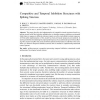Free Online Productivity Tools
i2Speak
i2Symbol
i2OCR
iTex2Img
iWeb2Print
iWeb2Shot
i2Type
iPdf2Split
iPdf2Merge
i2Bopomofo
i2Arabic
i2Style
i2Image
i2PDF
iLatex2Rtf
Sci2ools
NPL
2000
2000
Competitive and Temporal Inhibition Structures with Spiking Neurons
The paper describes the implementation of competitive neural structures based on a spiking neural model that includes multiplicative or shunting synapses enabling non-saturated stable states in response to different stationary inputs as well as controllable transient responses. A VLSI-viable implementation of this model has been previously proposed and tested [1]. It has the possibilityof modulating the output spike frequencybyan additional input without affecting other neuron variables such as the membrane potential.This feature is exploited in the simulation of a Selective Temporal Inhibition network that is suitable for implementing attentional control systems. Key words: spiking neurons, competitive processing, temporal inhibition, attentional control mechanisms, bio-inspired neural systems.
| Added | 19 Dec 2010 |
| Updated | 19 Dec 2010 |
| Type | Journal |
| Year | 2000 |
| Where | NPL |
| Authors | Eduardo Ros Vidal, Francisco J. Pelayo, P. Martin-Smith, Ignacio Rojas, D. Palomar, Alberto Prieto |
Comments (0)

